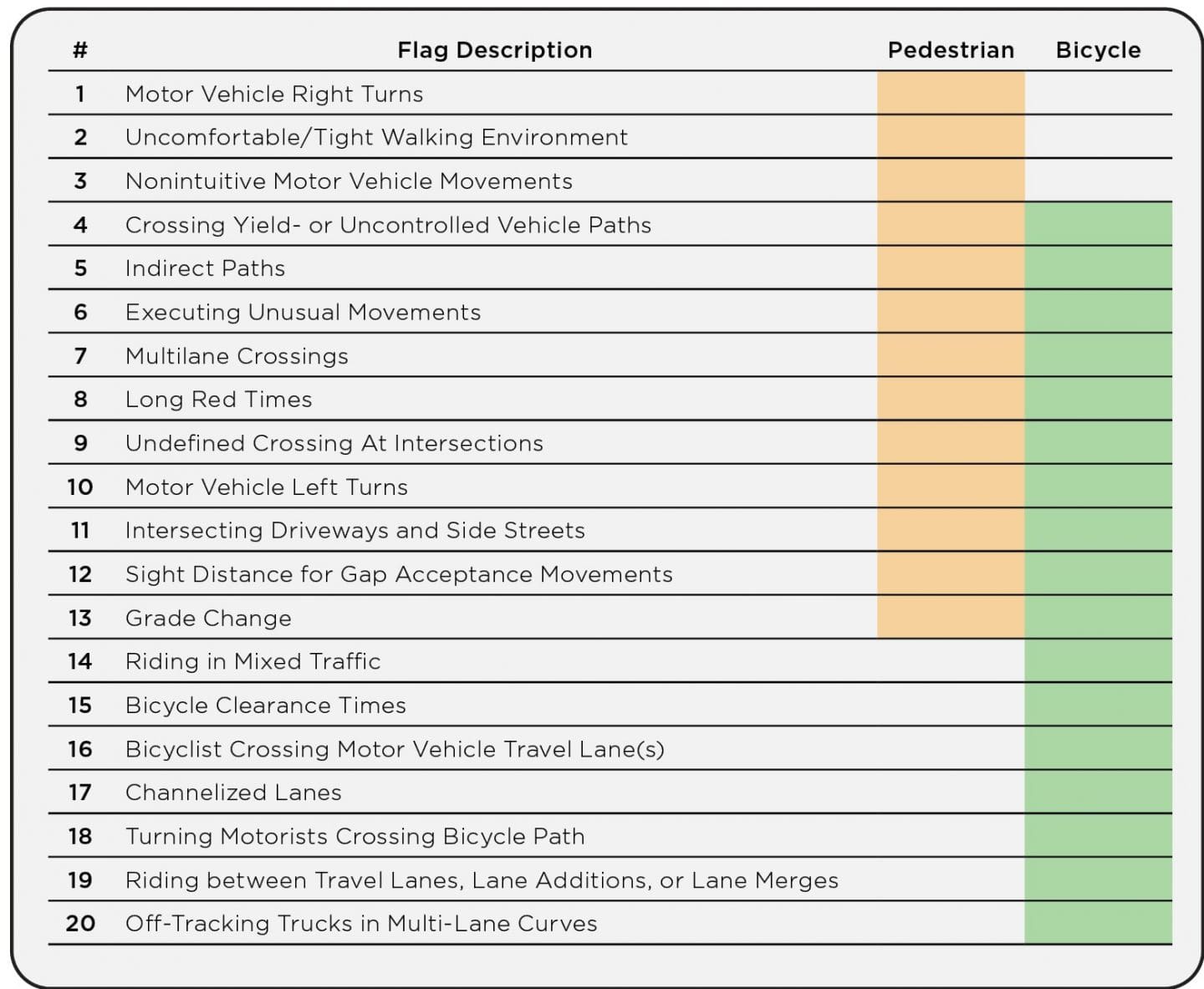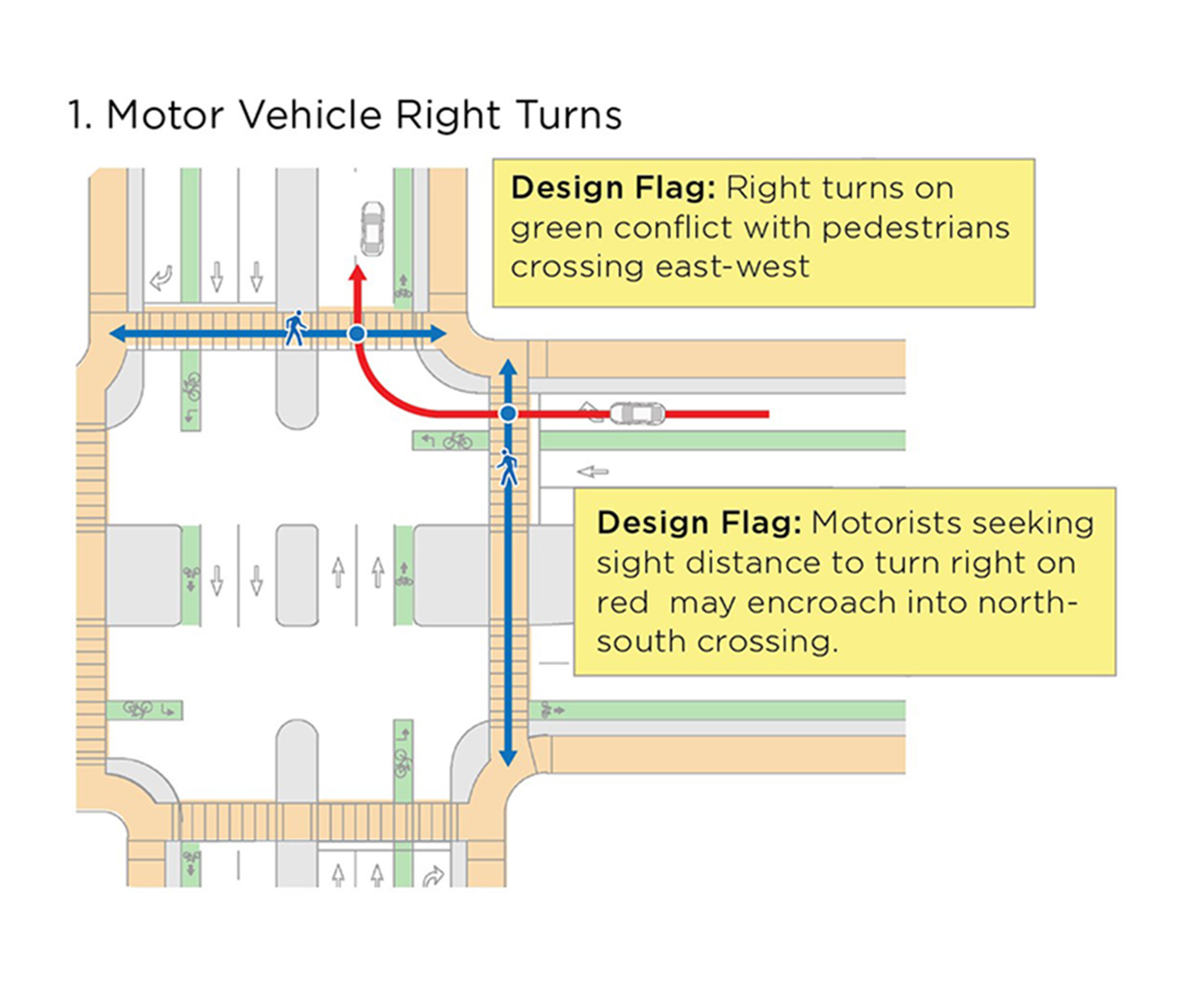April 14, 2020
In a Restricted Crossing U-Turn (RCUT) intersection, a driver makes a right turn, travels about 500 feet, then enters a left-turn lane to make a u-turn, rather than crossing or turning left on a high-speed road.
The RCUT is one of a number of alternative intersection and interchange designs that have emerged in the past decade. These designs remove or reduce the severity of vehicle conflict points, improving safety for motorists.
Traveling an extra 500 feet as a driver doesn’t take long, and the intersection design significantly reduces the chance of a severe or fatal car crash.
For a bicyclist at most RCUTs, however, crossing or turning left means contending with drivers in that 500 feet of roadway and a left-turn lane. For a pedestrian, it means crossing an unfamiliar intersection and encountering out-of-direction travel. Neither of these experiences are convenient or comfortable.
But are these experiences worse than at whatever the “conventional” alternative to the RCUT intersection would be? And what if there are ways to mitigate the safety and comfort concerns at the either intersection type? How can we compare these design alternatives for aspects of multimodal safety and comfort?
The experience for people walking and biking at an RCUT intersection reflects a common issue among many alternative intersections built to date: pedestrians and bicyclists have not been prioritized in the design. A guidebook from NCHRP addresses how this can be measured, and how improvements can be evaluated.
Alternative Intersections: Designed for Drivers
An RCUT is just one example of an Alternative Intersection and Interchange, or A.I.I., a category that encompasses complex intersections designed to improve efficiency and safety for drivers. Common A.I.I.s include the Diverging Diamond Interchange, Median U-Turn, Displaced Left Turn, Quadrant Roadway, Jughandle, and Continuous Green-T.
To achieve these benefits for drivers, A.I.I.s adjust geometric features – for example, a reversal of traffic lanes from their traditional directions – which can be unintuitive, or uncomfortable for people walking and biking and could increase their risk or exposure at the intersection. In addition, pedestrian paths and bicycle facilities may cross through islands or take different routes than expected. The concern is acute for pedestrians with disabilities.
NCHRP Report 948, “Guide for Pedestrian and Bicycle Safety at Alternative and Other Intersections and Interchanges,” is a response to these realities. Working with TRB and the project oversight panel, Kittelson & Associates led the development of a guidebook for transportation practitioners to improve pedestrian and bicycle safety and quality of service at intersections including A.I.I.s through planning, design, and operational treatments.
How To Apply NCHRP Report 948
After conducting a literature review, surveying agencies who have implemented A.I.I.s, and holding focus group sessions to understand the experience of pedestrians and bicyclists, our research team developed a quantitative analysis method built around 20 design flags.
These flags highlight design characteristics that impact safety and quality of service for people walking and biking regardless of the intersection type. Examples include tight walking environments, nonintuitive motor vehicles movements, grade changes, and motorists crossing bicycle paths. The list is meant to be worked through one-by-one in the design phase as a tool for evaluation and comparison.
Each of the 20 flags includes thresholds for a yellow flag and for a red flag at a given intersection. A yellow flag is generally associated with user comfort and a red flag with safety. Working through the list gives a percentage of red flags and a percentage of yellow flags for the intersection design being studied. The percentages allow for comparison of proposed designs and can be used in screening designs to move forward.


The flags can also be used to indicate where safety countermeasures would be appropriate. To assist practitioners with these design and countermeasure decisions, four chapters of the guidebook are dedicated to providing solutions to specific intersections.
A Methodology That Serves All Intersections
What we found in our research was that while these 20 design flags are present at alternative intersections, they are not unique to alternative intersections. The methodology applies to all intersections, not just A.I.I.s. Agencies that do not currently have any A.I.I.s will still benefit from the analysis provided in the guidebook.
This realization led to a title change midway through the project. What was originally named “Guide for Pedestrian and Bicycle Safety at Alternative Intersections and Interchanges (A.I.I.)” became “Guide for Pedestrian and Bicycle Safety at Alternative and Other Intersections and Interchanges.”
The methodology is also applicable at the planning level. It is easy to apply, and incorporating it at the planning level promotes the experience of pedestrians and bicyclists even earlier in a project – when changes are easiest to make.
Applying the Methodology with NCDOT
As part of our contract with the North Carolina Department of Transportation (NCDOT) Transportation Mobility and Safety Division (TMSD), Kittelson had the chance to lead a pedestrian and bicycle safety assessment in which we applied the NCHRP 07-25 methodology to multiple active projects in the design phase, putting this new guidance into action for North Carolina intersections.
After summarizing the percentage of red flags and percentage of yellow flags of proposed designs, NCDOT was able to raise awareness and identify design recommendations to enhance multimodal safety at several intersections. For at least one project, the quantitative assessment of multiple alternatives helped move forward a design that maximizes multimodal safety.
“In one case we were able to show conclusively that proposed innovative designs would be better for pedestrians and bicyclists than conventional designs, which helped us move the project along in the approvals process,” said Joseph Hummer, State Traffic Management Engineer at NCDOT. “In another case we were able to highlight where the draft design could be improved for better pedestrian and bicycle quality of experience with relatively minor tweaks now rather than expensive changes later. The methods developed for [NCHRP Report 948] will change the game for many projects.”
"The methods developed for [NCHRP Report 948] will change the game for many projects."
- Joseph Hummer, State Traffic Management Engineer, NCDOT
